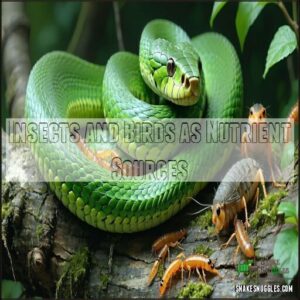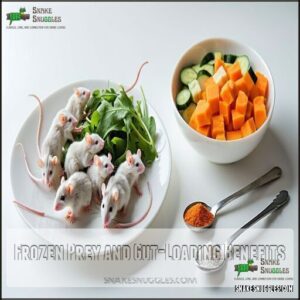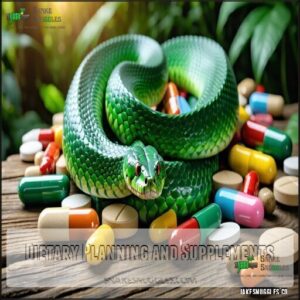This site is supported by our readers. We may earn a commission, at no cost to you, if you purchase through links.

Most snakes thrive on whole prey like mice, rats, birds, or insects, depending on the species.
Calcium and phosphorus are essential for bone strength, while vitamin D3 helps absorb those nutrients.
Protein is essential for muscle growth, so providing prey that matches your snake’s size and lifecycle is key.
Frozen-thawed prey is safer and more convenient than live feeding.
Adjust portions and frequency based on age—young snakes eat more often than adults.
A pinch of variety goes a long way, keeping diets both nutritious and natural.
This approach ensures that your snake receives a well-rounded diet that supports overall health and healthy snake growth.
Table Of Contents
- Key Takeaways
- Snake Nutrition Basics
- Prey Selection Guidelines
- Feeding Practices and Frequency
- Dietary Planning and Supplements
- Species-Specific Diets and Hydration
- Frequently Asked Questions (FAQs)
- How do you feed a snake a healthy diet?
- What should I eat if I have neutropenia?
- Do snakes need a good diet?
- What nutrients do snakes eat?
- How do you keep a snake healthy?
- Do snakes need a protein-rich diet?
- Can snakes be overfed and what are signs?
- How do environmental factors affect snake appetite?
- Are there vegetarian diets suitable for snakes?
- What is the impact of fasting on snakes?
- Conclusion
Key Takeaways
- Feed your snake whole prey like frozen-thawed mice or rats that match its girth to ensure proper nutrition and safety.
- Prioritize a balanced diet with protein, calcium, and vitamin D3 to support strong muscles and healthy bones.
- Adjust feeding frequency based on your snake’s age, with younger snakes eating more often than adults.
- Provide clean water daily, maintain appropriate humidity levels, and monitor your snake’s growth to ensure overall health.
Snake Nutrition Basics
To keep your snake healthy and growing, you’ll need to understand the basics of their nutrition.
A balanced diet with the right nutrients like protein, calcium, and Vitamin D3 is essential for their muscle and bone development.
Essential Nutrients for Snakes
Snakes need essential nutrients to thrive.
Protein quality supports muscle growth, while vitamins and minerals boost immunity and digestion.
Nutrient deficiencies can harm their health, so balance matters.
Fresh water meets hydration needs, aiding digestion and shedding.
Alongside snake nutrition essentials, calcium-phosphorus balance and vitamin D3 guarantee strong bones and growth.
Whole prey mimics their natural diet perfectly.
Calcium and Phosphorus Ratio
Getting the calcium-phosphorus balance right is key for proper bone development in snakes.
Optimal calcium-phosphorus balance is essential for strong bones and healthy growth, laying the foundation for your snake’s overall well-being.
Aim for an ideal ratio of 2:1 in their diet.
Too much phosphorus or insufficient calcium can lead to fragile bones and health issues.
Whole prey, like rodents, naturally meets this need.
Avoid over-supplementation, as it risks creating a harmful imbalance in your snake’s growth and overall health.
Vitamin D3 and Calcium Absorption
To support the calcium-phosphorus balance, vitamin D3 works like a team captain, ensuring calcium absorption and strong bones.
Vitamin D3 leads the charge, ensuring calcium absorption for stronger bones and keeping your snake healthy and thriving.
Provide UVB lighting for snakes to naturally produce vitamin D3 or use snake supplements carefully.
Consider these sources:
- Dietary items like gut-loaded insects.
- Supplement dosage following expert advice.
- Proper hydration impact for overall calcium metabolism.
MBD prevention starts here.
Protein and Muscle Growth
For healthy snake growth, protein fuels muscle development and supports every growth stage.
Whole prey, like mice or rats, acts as an ideal protein source in a snake diet for growth.
Prey nutrition impacts digestion efficiency, so guarantee meals are appropriate in size and variety.
Without enough protein, snake food fails to meet their vital muscle-building needs, hindering growth potential.
A balanced diet should also consider calcium and phosphorus for ideal nutrition.
Prey Selection Guidelines
Choosing the right prey is essential for your snake’s health and growth.
Match the prey size to your snake’s girth, and aim for a varied diet to provide balanced nutrition.
Prey Types and Dietary Variations
Understanding what snakes eat connects directly to their natural wild diets.
Prey diversity is key for balanced nutrition.
Common choices include:
- Mice and Rats for protein and fat.
- Insects offering fiber and calcium, especially when gut-loaded.
- Birds providing essential vitamins.
Matching prey variety to species-specific diets guarantees your snake gets the right nutritional profiles every meal.
Mice and Rats as Primary Protein Sources
Mice and rats are top choices for feeding snakes, providing high-protein content essential for muscle growth.
Prey size matters—choose rodents matching your snake’s girth.
Opt for frozen vs live to guarantee safety and minimize stress.
Always verify rodent source safety.
Gut loading rodents before feeding boosts their nutritional value, supporting your snake’s health.
| Aspect | Mice | Rats | Benefits |
|---|---|---|---|
| Ease of Availability | Widely available | Readily accessible | Convenient to source |
| Protein Content | Moderate | High | Supports muscle growth |
| Prey Size Options | Smaller options | Larger variety | Fits snake’s needs |
| Safety | Frozen recommended | Frozen recommended | Prevents harm |
The table highlights key differences between mice and rats, including ease of availability, protein content, and safety considerations.
By considering these factors, you can make an informed decision about the best prey for your snake, ensuring its muscle growth and overall well-being.
Insects and Birds as Nutrient Sources
Birds and insects make excellent alternative prey, enhancing dietary diversity.
Insects help small snakes thrive, but avoid wild-caught risks.
Use insect gut-loading to improve their calcium-phosphorus balance.
Birds, like chicks and quail, provide key nutrients for snake nutrition.
A balanced diet also guarantees proper gut health.
- Insects suit smaller snakes.
- Birds offer high protein.
- Gut-loading boosts insect value.
- Avoid toxic wild insects.
- Birds improve vitamin intake.
Whole Prey and Natural Diet
A snake’s natural diet is all about whole prey, just like in the wild.
Prey items, including mice, rats, and birds, deliver essential nutrients through their gut content.
Matching the snake prey size to its girth prevents problems, and ethical sourcing guarantees safe meals.
This snake feeding guide highlights the importance of whole prey to mimic wild snake diets and encourage natural behaviors.
Feeding Practices and Frequency
When feeding your snake, it’s important to choose prey that matches its size and nutritional needs while maintaining a safe feeding schedule.
Understanding the right frequency and handling practices guarantees proper growth and keeps your pet healthy.
Safe Prey Handling and Presentation
Switching to feeding practices, safe prey handling is a must. Always use food tongs for thawing prey to prevent bites when offering prekilled food.
Proper presentation methods mimic live prey movement, triggering natural feeding instincts. Gut loading insects guarantees added nutrition before feeding.
Consider using specialized feeding equipment for safer handling. Remember:
- Handle frozen prey hygienically.
- Avoid injury with tongs.
- Keep thawed food at room temperature to ensure proper presentation.
Feeding Frequency by Age and Species
A proper snake feeding schedule depends on its age and species.
Hatchlings require meals every 5-7 days to fuel growth. Juveniles typically eat every 7-10 days, while adult intervals extend to 10-14 days based on metabolic rates.
Different snake species might’ve unique needs, so always adjust feeding frequency to fit their natural habits and your snake’s diet.
Frozen Prey and Gut-Loading Benefits
Frozen snake food is a safe and convenient option, promoting stress-free feeding behaviors.
Gut-loading prey items boosts calcium, vitamin D3, and overall nutrition.
For best results, follow these steps:
- Freeze prey for safe storage.
- Gutload with nutrient-rich foods.
- Thaw prey using proper methods.
- Present prey naturally to enhance feeding responses.
This guarantees balanced nutrition and healthier snakes.
Always handle the food using clean feeding tongs to prevent contamination.
Monitoring Growth and Adjusting Feeding Schedules
Tracking your snake’s growth rate and weight trends helps fine-tune its feeding schedule. Regular weight checks guarantee proper prey size adjustment and supplement dosage control.
As snakes grow, increase prey size gradually. Monitor hydration levels and stool quality to spot issues early.
Adjust feeding frequency based on age and size for balanced nutrition, supporting healthy snake growth and weight management.
Dietary Planning and Supplements
Planning your snake’s diet guarantees it gets the right mix of nutrients for proper growth.
Using supplements like calcium, vitamin D3, and multivitamins can help fill any gaps and keep your pet healthy.
Variety in Prey Selection and Nutrient Intake
Offering prey variety keeps snake nutrition balanced and mimics wild diets.
Different snake prey items, like mice, birds, or insects, provide unique nutrients, supporting a well-rounded diet.
Seasonal variation in prey guarantees nutrient balance and reflects natural feeding habits.
Without prey diversity, dietary deficiencies may arise, affecting growth.
A balanced diet supports healthy health, keeping your snake thriving naturally.
Nutritional Value of Prey Types and Seasonal Adjustments
Wild snakes thrive on varied prey, each offering unique nutrient profiles.
Captive snakes benefit from seasonal dietary shifts, mimicking natural feeding patterns.
Prey variety guarantees balanced nutrition, supporting calcium-phosphorus balance and vitamin D3 absorption.
Gut-loading insects boosts their value, while aligning prey selection with seasons prevents deficiencies.
Focusing on dietary diversity importance enhances your snake’s overall health and mirrors its wild feeding habits, emphasizing the need for balanced nutrition.
Calcium and Vitamin D3 Supplements
How can you guarantee your snake gets the right calcium and vitamin D3?
Supplements play a key role, especially for indoor snakes.
Here’s what to know:
- Aim for a 2:1 calcium-phosphorus balance.
- Provide UVB lighting for D3 synthesis.
- Dust prey with calcium powder weekly.
- Use liquid vitamin D3 supplements cautiously.
- Prevent MBD by monitoring calcium absorption regularly.
Many owners find snake calcium supplements beneficial for their reptiles.
Multivitamins and Avoiding Over-Supplementation
Vitamin supplements can boost snake nutritional balance, but too much causes vitamin toxicity.
Focus on multivitamin benefits by addressing deficiencies, not overloading with unnecessary nutrients. Dosage control matters—follow product instructions carefully.
Space out supplement timing to avoid stress on your snake. Snake vitamins, like vitamin D3, support mineral absorption, but moderation is key.
Identify deficiencies through diet and observation first.
Species-Specific Diets and Hydration
Feeding your snake the right diet depends on its species, as each has unique nutritional needs.
Fresh water and proper humidity are just as important to keep your snake healthy and thriving.
Species-Specific Dietary Needs and Preferences
Snake dietary variations depend on species, size, and habitat.
For instance, the Corn Snake Diet focuses on small rodents, while Python Prey Choices include larger rats or birds.
King Cobra Food often involves other snakes, highlighting its predatory nature.
Garter Snake Meals include fish and frogs, suiting aquatic preferences.
Arboreal Snake Diets often feature birds, matching tree-dwelling lifestyles.
Captive snakes often thrive on commercial frozen rodents, offering a safe and nutritious alternative to live prey, which is a key aspect of their dietary needs.
Commercial Snake Food and Homemade Diets
Commercial brands offer ready-to-use options for snake nutrition, yet homemade diets provide flexibility for prey selection.
Balancing nutrients, like calcium-phosphorus, is vital. Homemade balancing guarantees nutritional completeness, but consult a vet for safety.
These diets should suit your snake species’ dietary requirements. Both approaches focus on food safety and aligning with natural needs to support growth.
Diet diversification can offer additional enrichment, as whole prey items provide balanced nutrition.
Providing Fresh Water and Maintaining Humidity
Don’t overlook water and humidity—they’re key to your snake’s health.
A sturdy water bowl sized for easy access helps with hydration and shedding. Monitor humidity to prevent respiratory issues and support proper shedding cycles.
- Use a hygrometer to track humidity levels.
- Refill water daily to keep it clean.
- Adjust humidity to match your snake’s environment.
Signs of Dehydration and Importance of Hydration
Wrinkled skin, sunken eyes, and shedding issues are common dehydration symptoms in snakes.
A sturdy water bowl with fresh water supports hydration benefits and aids shedding.
Proper humidity levels also play a key role, as they prevent dehydration linked to environmental conditions.
Always monitor snake hydration closely to verify their water needs align with their overall snake diet water requirements, ensuring proper humidity levels are maintained.
Frequently Asked Questions (FAQs)
How do you feed a snake a healthy diet?
Don’t toss them a pizza slice.
Offer prey matching their girth, like frozen-thawed rodents or birds.
Feed based on age and size, make certain fresh water daily, and supplement calcium and vitamin D3 when needed.
What should I eat if I have neutropenia?
If you have neutropenia, focus on eating well-cooked foods, avoiding raw or undercooked meats, seafood, and eggs.
Stick to pasteurized products, peel fruits and vegetables, and avoid unpasteurized juices.
Always prioritize hygiene when handling food.
Do snakes need a good diet?
A snake’s diet is like fuel for a car—it drives their growth, health, and energy.
Providing proper nutrients like protein, calcium, and vitamins guarantees strong muscles, healthy bones, and a thriving, active pet.
What nutrients do snakes eat?
Snakes need proteins for growth, calcium and phosphorus for strong bones, vitamin D3 for calcium absorption, and trace minerals like zinc and iron for immunity and metabolism.
Fresh water guarantees hydration and overall health.
How do you keep a snake healthy?
Prioritize proper prey, perfect hydration, and pristine conditions.
Offer a varied diet matching its species, guarantee clean water always, maintain correct humidity and temperature.
Monitor health regularly to sustain your snake’s strength and vitality, keeping it in good health.
Do snakes need a protein-rich diet?
A protein-rich diet is essential for your snake’s growth and overall health.
It supports muscle development and energy needs.
Whole prey like mice and rats provides the perfect balance of protein and essential nutrients.
Can snakes be overfed and what are signs?
Yes, you can overfeed your snake.
Signs include obesity, lethargy, refusing food, and regurgitation.
Feed appropriate prey sizes on a proper schedule.
Overfeeding shortens lifespan and affects health—stick to a balanced feeding routine instead.
How do environmental factors affect snake appetite?
Picture a rainy day dampening your mood—similarly, temperature, humidity, or lighting shifts can reduce a snake’s appetite.
If it’s too cold, poorly lit, or dry, they might eat less or refuse food entirely, which can be a significant issue due to environmental factors.
Are there vegetarian diets suitable for snakes?
Snakes can’t thrive on vegetarian diets since they’re strict carnivores.
Their bodies require nutrients from meat-based prey like rodents and birds to support growth, muscle development, and overall health.
Plant-based diets aren’t suitable.
What is the impact of fasting on snakes?
Did you know some snakes can fast for months without harm.
Occasional fasting mimics natural cycles, helps manage obesity, and resets digestion.
However, prolonged fasting can weaken growth and health, so watch for warning signs.
Conclusion
While it may seem complex, creating the best diet for healthy snake growth is simpler with a clear plan.
Choose whole prey suited to your snake’s size and species, ensuring balanced nutrients like calcium, phosphorus, and vitamin D3. Stick to frozen-thawed prey for safety, adjust feeding frequency based on age, and add variety for ideal nutrition.
Monitor growth and provide clean water. A thoughtful approach keeps your snake healthy, active, and growing strong. Start today!
- https://commons.wikimedia.org/wiki/File:Ball_python_lucy.JPG
- https://creativecommons.org/licenses/by-sa/3.0
- https://talis-us.com/blogs/news/the-best-snake-food-for-a-well-nourished-pet?srsltid=AfmBOootlzSQIcTBxh5oMcgZTaeZS_DvxFoJn0Z5r3oS9BRdu_rDZgyK
- https://www.dvm360.com/view/current-thoughts-reptile-nutrition-proceedings
- https://www.labmanager.com/snakes-the-new-high-protein-superfood-31943

















